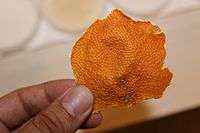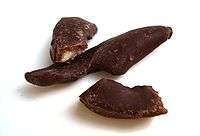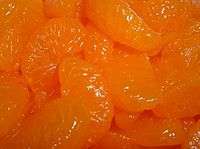Mandarin orange
The mandarin orange (Citrus reticulata), also known as the mandarin or mandarine, is a small citrus tree with fruit resembling other oranges, usually eaten plain or in fruit salads.[1] The tangerine is a group of orange-coloured citrus fruit consisting of hybrids of mandarin orange.
| Mandarin orange | |
|---|---|
| Scientific classification | |
| Kingdom: | Plantae |
| Clade: | Tracheophytes |
| Clade: | Angiosperms |
| Clade: | Eudicots |
| Clade: | Rosids |
| Order: | Sapindales |
| Family: | Rutaceae |
| Genus: | Citrus |
| Species: | C. reticulata |
| Binomial name | |
| Citrus reticulata Blanco, 1837 | |
Mandarins are smaller and oblate, rather than spherical, like the common oranges (which are a mandarin hybrid).[1] The taste is considered less sour, as well as sweeter and stronger.[2] A ripe mandarin is firm to slightly soft, heavy for its size, and pebbly-skinned. The peel is thin, with little white mesocarp,[3] so they are usually easier to peel and to split into segments.[1] Hybrids generally have these traits to a lesser degree. The mandarin is tender and is damaged easily by cold. It can be grown in tropical and subtropical areas.[1][2]
According to genetic studies, the mandarin was one of the original citrus species; through breeding or natural hybridization, it is the ancestor of many hybrid citrus cultivars. With the citron and pomelo, it is the ancestor of the most commercially important hybrids (such as sweet and sour oranges, grapefruit, and many lemons and limes). The mandarin has also been hybridized with other citrus species, such as the desert lime and the kumquat.[4] Though the ancestral mandarin was bitter, most commercial mandarin strains derive from hybridization with pomelo, which gave them a sweet fruit.[5]
Etymology
Citrus reticulata is from Latin, where reticulata means "netted".[6] The name mandarin orange is a calque of Swedish mandarin apelsin [apelsin from German Apfelsine (Apfel + Sina) meaning Chinese apple], first attested in the 18th century. The form "mandarine" derives from the French name for this fruit. The reason for the epithet "mandarin" is not clear; it may relate to the yellow colour of some robes worn by mandarin dignitaries.[7][8]
Botany
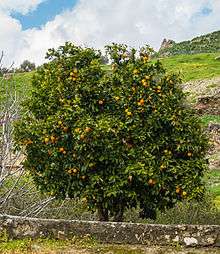
Citrus reticulata is a moderate-sized tree some 7.6 metres (25 ft) in height.[1][6] The tree trunk and major branches have thorns.[1] The leaves are shiny and green, rather small.[1] The petioles are short, almost wingless or slightly winged.[1] The flowers are borne singly or in small groups in the leaf-axils.[1] Citrus are usually self-fertile (needing only a bee to move pollen within the same flower) or parthenocarpic (not needing pollination and therefore seedless, such as the satsuma). A mature mandarin tree can yield up to 79 kilograms (175 lb) of fruit.[9]
Fruit
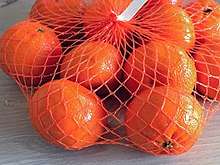
Mandarin orange fruits are small 40–80 millimetres (1.6–3.1 in).[1] Their colour is orange, orange-yellow, or orange-red.[2] The skin is thin and peels off easily.[1] Their easiness to peel is an important advantage of mandarin oranges over other citrus fruits.[2] Just like with other citrus fruits, the endocarp (inner flesh) is separated into segments, which in their turn consist of a large number of elongated cells.[1] The fruits may be seedless or contain a small number of seeds. Mandarin orange fruits are sweet to taste, and can be eaten as whole or squeezed to make juice.[1][2]
Production
| Tangerines, mandarins, clementines, satsumas Production, 2017 (millions of tonnes) | |
|---|---|
In 2017, world production of mandarin oranges (combined with tangerines, clementines, and satsumas in reporting to FAOSTAT) was 33.4 million tonnes, led by China with 54% of the global total (table).[10] Producing more than one million tonnes each in 2017 were Spain, Turkey, Morocco, Brazil, and Egypt.[10]
Uses
Fresh
Mandarins are generally peeled and eaten fresh or used in salads, desserts and main dishes.[1] Fresh mandarin juice and frozen juice concentrate are commonly available in the United States. The number of seeds in each segment (carpel) varies greatly.
Peel
The peel is used fresh, whole or zested, or dried as chenpi. It can be used as a spice for cooking, baking, drinks, or candy. Essential oil from the fresh peel may be used as a flavouring for candy, in gelatins, ice cream, chewing gum, and baked goods.[1] It is also used as a flavouring in liqueurs.[1] In Chinese cuisine, the peel of the mandarin orange, called chenpi, is used to flavor sweet dishes and sauces.
Canning
Canned mandarin segments are peeled to remove the white pith prior to canning; otherwise, they turn bitter. Segments are peeled using a chemical process. First, the segments are scalded in hot water to loosen the skin; then they are bathed in a lye solution, which digests the albedo and membranes. Finally, the segments are rinsed several times in plain water. Once orange segments are properly prepared, mandarin oranges undergo heat processing to remove bacteria that can cause spoilage. The oranges are then packed in airtight sealed containers. Ascorbic acid may also be added.
Traditional medicine
In traditional Chinese medicine, the dried peel of the fruit is used in regulation of ch'i and to enhance digestion.[11]
Nutrition
| Nutritional value per 100 g (3.5 oz) | |
|---|---|
| Energy | 223 kJ (53 kcal) |
13.34 g | |
| Sugars | 10.58 g |
| Dietary fibre | 1.8 g |
0.31 g | |
0.81 g | |
| Vitamins | Quantity %DV† |
| Vitamin A equiv. | 4% 34 μg1% 155 μg |
| Thiamine (B1) | 5% 0.058 mg |
| Riboflavin (B2) | 3% 0.036 mg |
| Niacin (B3) | 3% 0.376 mg |
| Pantothenic acid (B5) | 4% 0.216 mg |
| Vitamin B6 | 6% 0.078 mg |
| Folate (B9) | 4% 16 μg |
| Choline | 2% 10.2 mg |
| Vitamin C | 32% 26.7 mg |
| Vitamin E | 1% 0.2 mg |
| Minerals | Quantity %DV† |
| Calcium | 4% 37 mg |
| Iron | 1% 0.15 mg |
| Magnesium | 3% 12 mg |
| Manganese | 2% 0.039 mg |
| Phosphorus | 3% 20 mg |
| Potassium | 4% 166 mg |
| Sodium | 0% 2 mg |
| Zinc | 1% 0.07 mg |
| Other constituents | Quantity |
| Water | 85.2 g |
| |
| †Percentages are roughly approximated using US recommendations for adults. Source: USDA Nutrient Database | |
A mandarin orange contains 85% water, 13% carbohydrates, and negligible amounts of fat and protein (table). Among micronutrients, only vitamin C is in significant content (32% of the Daily Value) in a 100-gram reference serving, with all other nutrients in low amounts.
Cultural significance
During Chinese New Year, mandarin oranges/tangerine/satsumas are considered traditional symbols of abundance and good fortune. During the two-week celebration, they are frequently displayed as decoration and presented as gifts to friends, relatives, and business associates. Mandarin oranges, particularly from Japan, are a Christmas tradition in Canada, the United States and Russia.
In Canada and the United States, they are commonly purchased in 5- or 10-pound boxes,[2] individually wrapped in soft green paper, and given in Christmas stockings. This custom goes back to the 1880s, when Japanese immigrants in the United States began receiving Japanese mandarin oranges from their families back home as gifts for the New Year. The tradition quickly spread among the non-Japanese population, and eastwards across the country: each November harvest, "The oranges were quickly unloaded and then shipped east by rail. 'Orange Trains' – trains with boxcars painted orange – alerted everyone along the way that the irresistible oranges from Japan were back again for the holidays. For many, the arrival of Japanese mandarin oranges signaled the real beginning of the holiday season."[12] This Japanese tradition merged with European traditions related to the Christmas stocking. Saint Nicholas is said to have put gold coins into the stockings of three poor girls so that they would be able to afford to get married.[13] Sometimes the story is told with gold balls instead of bags of gold, and oranges became a symbolic stand-in for these gold balls, and are put in Christmas stockings in Canada[13][14] along with chocolate coins wrapped in gold foil.
Satsumas were also grown in the United States from the early 1900s, but Japan remained a major supplier.[15] U.S. imports of these Japanese oranges was suspended due to hostilities with Japan during World War II.[12] While they were one of the first Japanese goods allowed for export after the end of the war, residual hostility led to the rebranding of these oranges as "mandarin" oranges.[12]
The delivery of the first batch of mandarin oranges from Japan in the port of Vancouver, British Columbia (Canada), is greeted with a festival that combines Santa Claus and Japanese dancers[14]—young girls dressed in traditional kimonos.[16]
Historically, the Christmas fruit sold in North America was mostly Dancys, but now it is more often a hybrid.[17]
Genetics and origin
Mandarins are one of the core ancestral citrus taxa, and are thought to have evolved in regions including South China and Japan in East Asia, and Vietnam in Southeast Asia.[18][5] Mandarins appear to have been domesticated at least twice, in the north and south Nanling Mountains. Wild mandarins are still found there, including Daoxian mandarines (sometimes given the species name Citrus daoxianensis) as well as some members of the group traditionally called 'Mangshan wild mandarins', a generic grouping for the wild mandarin-like fruit of the Mangshan area that includes both true mandarins and the genetically-distinct and only distantly-related Mangshanyegan. The wild mandarins were found to be free of the introgressed pomelo (C. maxima) DNA found in domestic mandarins but they did appear to have small amounts (~1.8%) of introgression from the ichang papeda, which grows wild in the same region.[19]
The Nanling Mountains are also home to northern and southern genetic clusters of domestic mandarins that have similar levels of sugars in the fruit compared to their wild relatives, but appreciably (in some almost 90-fold) lower levels of citric acid. The clusters display different patterns of pomelo introgression, have different deduced historical population histories, and are most closely related to distinct wild mandarins, suggesting two independent domestications in the north and south.[19] All tested domesticated cultivars were found to belong to one of these two genetic clusters, with varieties such as Nanfengmiju, Kishu and Satsuma deriving from the northern domestication event producing larger, redder fruit, while Willowleaf, Dancy, Sunki, Cleopatra, King, Ponkan, and others derived from the smaller, yellower-fruited southern cluster.[19]
The Tanaka classification system divided domestic mandarins and similar fruit into numerous species, giving distinct names to cultivars such as willowleaf mandarins (C. deliciosa), satsumas (C. unshiu), tangerines (C. tangerina). Under the Swingle system, all these are considered to be varieties of a single species, Citrus reticulata.[20] Hodgson represented them as several subgroups: common (C. reticulata), Satsuma, King (C. nobilis), Mediterranean (willowleaf), small-fruited (C. indica, C. tachibana and C. reshni), and mandarin hybrids.[21]
Genetic analysis is consistent with mandarins representing a single species, with much of the variation within mandarins being due to hybridization.[4] There are only a small number of genetically-pure cultivars, including the Tachibana orange, which Talon determined to be sufficiently divergent to be classified as a distinct subspecies,Citrus reticulata tachibana[4] and found by Wang to have branched from the wild mandarin lineage prior to the split that gave rise to the two domesticated clusters. Others, such as Sun Chu Sha mandarin[18][4] and Nanfengmiju,[22] were found to be pure in initial genomic characterization, but Wang detected in them not only an apparent Ichang papeda introgression found in all examined mandarins but also the distinct pomelo DNA of the domesticated mandarins.[19] Following initial hybridization, cultivars were produced by backcrossing the initial mandarin-pomelo hybrids to produce mandarins with limited pomelo contribution,[4] that differed between the northern and southern domesticates.[19] An 'acidic' group of cultivars including Sunki and Cleopatra mandarins that likewise previously were thought to be pure but since found to contain small regions of introgressed pomelo DNA are too sour to be edible, but are widely used as rootstock and grown for juice.[20][4] Another group of mandarins, including some tangerines, Satsuma and King mandarins, show a greater pomelo contribution and derive from the limited-pomelo hybrids being crossed again, with sweet orange or pomelo, and likewise backcrossing in some cases, producing cultivars with moderate to high levels of pomelo introgression.[4] Hybrid mandarins thus fall on a continuum of increasing pomelo contribution with clementines, sweet and sour oranges, and grapefruit.[18] Mandarins and their hybrids are sold under a variety of names. In the genomic-based species taxonomy of Ollitrault et al., only pure mandarins would fall under C. reticulata, while the pomelo admixture found in the majority would cause them to be classified as varieties of C. aurantium.[23]
Varieties
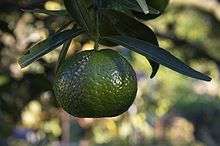
Stem mandarins (Citrus reticulata)
Domesticated mandarins and hybrids
(Species names are those from the Tanaka system. Recent genomic analysis would place them all in Citrus reticulata.[4])
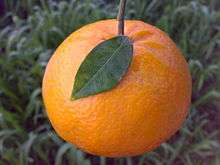
- Sun Chu Sha[18][4]
- Nanfengmiju - one of the most widely cultivated varieties in China.[22]
- Cleopatra mandarin,[18] acidic mandarin containing very small amount of pomelo introgression[4].
- Sunki,[18] acidic mandarin containing very small amount of pomelo introgression[4].
- Tangerines (Citrus tangerina)[24] is a grouping used for several distinct mandarin hybrids. Those sold in the US as tangerines have usually been Dancy, Sunburst or Murcott (Honey) cultivars. Some tangerine-grapefruit hybrids are legally sold as tangerines in the USA.[25][26]
- Mediterranean/Willowleaf/Thorny (Citrus × deliciosa), a mandarin with small amounts of pomelo[27].
- Huanglingmiao (Citrus reticulata), a mandarin–pomelo hybrid[4][28].
- Kishumikan (Citrus reticulata), or simply Kishu, close clonal relative of Huanglingmiao, the two sharing a common origin before diverging as they were propagated[4]
- Kunenbo (Citrus nobilis) a heterogeneous group that includes at least four distinct mandarin-pomelo hybrids.[29]
- King (in full, 'King of Siam', Citrus nobilis) a Kunenbo mandarin with high levels of pomelo admixture, sometimes classed as a tangor.[4][29]
- Kinnow (see image), a King-Willowleaf hybrid.
- Satsuma (Citrus unshiu), a mandarin-pomelo hybrid with more pomelo than seen in most mandarins. It derived from a cross between a Huanglingmiao/Kishu and a non-King Kunenbo that was itself a pomelo-Huanglingmiao/Kishu cross.[4][29] It is a seedless variety, of which there are over 200 cultivars, including Wenzhou migana, Owari, and mikan; the source of most canned mandarins, and popular as a fresh fruit due to its ease of consumption
- Owari, a well-known Satsuma cultivar that ripens during the late autumn
- King (in full, 'King of Siam', Citrus nobilis) a Kunenbo mandarin with high levels of pomelo admixture, sometimes classed as a tangor.[4][29]
- Komikan, a variety of Kishumikan[29]
- Kunenbo (Citrus nobilis) a heterogeneous group that includes at least four distinct mandarin-pomelo hybrids.[29]
- The Ponkan ( Citrus reticulata), a mandarin–pomelo hybrid[18][27]
- The Dancy tangerine (Citrus tangerina) is a hybrid, the cross of a Ponkan with another unidentified hybrid mandarin.[4] Until the 1970s, most tangerines grown and eaten in the USA were Dancys, and it was known as "Christmas tangerine"[17] and zipper-skin tangerine[30]
- Iyokan (Citrus iyo), a cross between the Dancy tangerine and another Japanese mandarin variety, the kaikoukan.[29]
- The Dancy tangerine (Citrus tangerina) is a hybrid, the cross of a Ponkan with another unidentified hybrid mandarin.[4] Until the 1970s, most tangerines grown and eaten in the USA were Dancys, and it was known as "Christmas tangerine"[17] and zipper-skin tangerine[30]
- Bang Mot tangerine, a mandarin variety popular in Thailand.
- Shekwasha (Citrus depressa), a very sour mandarin grown for its acidic juice, has admixture from both pomelo and citron[31]
Mandarin crosses
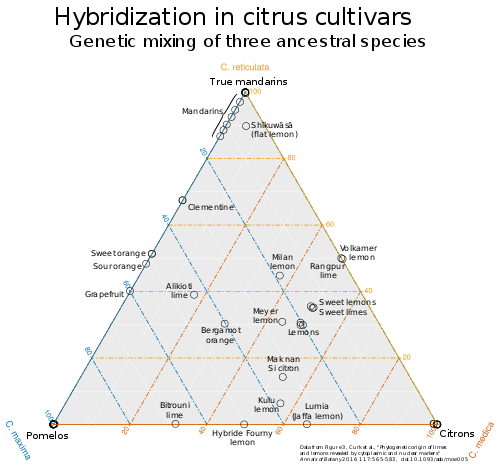
- Tangelos, a generic term for modern mandarin (tangerine)-pomelo and mandarin-grapefruit crosses
- The Mandelo or 'cocktail grapefruit', a cross between a Dancy/King mixed mandarin and a pomelo.[4] The term is also sometimes used generically, like tangelo, for recent mandarin-pomelo hybrids.
- The sour orange (Citrus x aurantium) derives from a direct cross between a pure mandarin and a pomelo[28]
- The common sweet orange (Citrus x sinensis), derives from a cross between non-pure mandarin and pomelo parents[28]
- Tangors, or Temple oranges, are crosses between the mandarin orange and the common sweet orange;[28] their thick rind is easy to peel and its bright orange pulp is sour-sweet and full-flavoured. Some such hybrids are commonly called mandarins or tangerines.
- Clementine (Citrus × clementina), a spontaneous hybrid between a Willowleaf mandarin orange and a sweet orange.[27][32] sometimes known as a "Thanksgiving Orange" or "Christmas orange", as its peak season is winter; an important commercial mandarin orange form, having displaced mikans in many markets.
- Murcott, a mandarin–sweet orange hybrid,[27][34] one parent being the King.[35]
- Tango is a proprietary seedless mid-late season irradiated selection of Murcott developed by the University of California Citrus Breeding Program.[9]
- Grapefruit (Citrus x paradisi), the result of backcrossing the sweet orange with pomelo
- Meyer lemon (Citrus x meyer), a cross between a mandarin × pomelo hybrid and a citron.[31]
- Palestinian sweet lime (Citrus x limettioides), a distinct (mandarin × pomelo) × citron hybrid[31]
- Tangors, or Temple oranges, are crosses between the mandarin orange and the common sweet orange;[28] their thick rind is easy to peel and its bright orange pulp is sour-sweet and full-flavoured. Some such hybrids are commonly called mandarins or tangerines.
- Rangpur lime (Citrus x limonia), a pure mandarin-citron cross[31]
- Rough lemon (Citrus x jambhiri), a pure mandarin-citron cross, distinct from rangpur[31]
- Jabara (Citrus jabara), a Kunenbo mandarin-yuzu cross.[29]
Non-mandarins
- Mangshanyegans, long thought to be mandarins, are in fact a separate species.[28]
See also
- Japanese citrus
- List of citrus fruits
- Tangerine
- Citrus unshiu
- Ju Song – "In Praise of the Orange-Tree"
References
- Julia F. Morton (1987). "Mandarin orange; In: Fruits of Warm Climates, p. 142–145". NewCROP, the New Crop Resource Online Program, Center for New Crops and Plant Products, Purdue University. Retrieved 8 March 2019.
- David Karp (3 February 2016). "Mandarin oranges, rising stars of the fruit bowl". The New York Times. Retrieved 7 February 2019.
- David Karp (13 March 2014). "Market watch: The wild and elusive Dancy". Los Angeles Times. Retrieved 7 February 2019.
- Wu, Guohong Albert; Terol, Javier; Ibanez, Victoria; López-García, Antonio; Pérez-Román, Estela; Borredá, Carles; Domingo, Concha; Tadeo, Francisco R; Carbonell-Caballero, Jose; Alonso, Roberto; Curk, Franck; Du, Dongliang; Ollitrault, Patrick; Roose, Mikeal L. Roose; Dopazo, Joaquin; Gmitter Jr, Frederick G.; Rokhsar, Daniel; Talon, Manuel (2018). "Genomics of the origin and evolution of Citrus" (PDF). Nature. 554 (7692): 311–316. Bibcode:2018Natur.554..311W. doi:10.1038/nature25447. PMID 29414943. and Supplementary information
- Wang, L; He, F; Huang, Y; He, J; Yang, S; Zeng, J; Deng, C; Jiang, X; Fang, Y; Wen, S; Xu, R; Yu, H; Yang, X; Zhong, G; Chen, C; Yan, X; Zhou, C; Zhang, H; Xie, Z; Larkin, RM; Deng, X; Xu, Q (6 August 2018). "Genome of wild mandarin and domestication history of mandarin". Molecular Plant. 11 (8): 1024–1037. doi:10.1016/j.molp.2018.06.001. ISSN 1674-2052. PMID 29885473.
- "Citrus reticulata, 'Clementine'". Missouri Botanical Garden. 2019. Retrieved 8 March 2019.
- "Chinese loanwords in the OED". The Free Library. Retrieved October 5, 2016.
- "Mandarin | Origin and meaning of mandarin". www.etymonline.com. Retrieved 12 February 2018.
- "Citrus reticulata Blanco; Tango mandarin". University of California - Riverside; College of Natural and Agricultural Sciences; Citrus Variety Collection. 2010. Retrieved 8 March 2019.
- "Mandarin orange production in 2017, Crops/Regions/World list/Production Quantity (pick lists)". UN Food and Agriculture Organization, Corporate Statistical Database (FAOSTAT). 2017. Retrieved 8 March 2019.
- Yeung. Him-Che. Handbook of Chinese Herbs and Formulas. 1985. Los Angeles: Institute of Chinese Medicine.
- "Information on This Week's Product: Mandarin Oranges" (PDF). BC Agriculture in the Classroom Foundation. Retrieved 24 January 2013.
- "Personalized Christmas Stockings". centrinet.com. Archived from the original on 21 October 2008. Retrieved 15 January 2013.
- Marion, Paul (December 19, 2010). "Oranges at Christmas". richardhowe.com: Lowell Politics and Lowell History. Retrieved 15 January 2013.
- "HS195/CH116: The Satsuma Mandarin". Edis.ifas.ufl.edu. 2014-11-19. Retrieved 2018-04-09.
- "Christmas Stockings". Christmas Traditions in France and in Canada. Ministère de la culture et de la communication de France. Retrieved 15 January 2013.
- Dancy Tangerine Citrus Tangerina v. Dancy, Ark of Taste Catalogue http://www.slowfoodusa.org/ark-item/dancy-tangerine Archived 2016-04-09 at the Wayback Machine
- Curk, Franck; Ancillo, Gema; Garcia-Lor, Andres; Luro, François; Perrier, Xavier; Jacquemoud-Collet, Jean-Pierre; Navarro, Luis; Ollitrault, Patrick (2014). "Next generation haplotyping to decipher nuclear genomic interspecific admixture in Citrus species: analysis of chromosome 2". BMC Genetics. 15: 152. doi:10.1186/s12863-014-0152-1. PMC 4302129. PMID 25544367.
- Wang, Lun; et al. (2018). "Genome of Wild Mandarin and Domestication History of Mandarin". Molecular Plant. 11 (8): 1024–1037. doi:10.1016/j.molp.2018.06.001. PMID 29885473.
- Froelicher, Yann; Mouhaya, Wafa; Bassene, Jean-Baptiste; Costantino, Gilles; Kamiri, Mourad; Luro, Francois; Morillon, Raphael; Ollitrault, Patrick (2011). "New universal mitochondrial PCR markers reveal new information on maternal citrus phylogeny". Tree Genetics. 7: 49–61. doi:10.1007/s11295-010-0314-x.
- Goldenberg, Livnat; Yaniv, Yossi; Porat, Ron; Carmi, Nir (2018). "Mandarin fruit quality: a review". Journal of the Science of Food and Agriculture. 98 (1): 18–26. doi:10.1002/jsfa.8495. PMID 28631804.
- "The Seedless Kishu, a small but mighty mandarin". latimes. 2010-01-13.
- Ollitrault, Patrick; Curk, Franck; Krueger, Robert (2020). "Citrus taxonomy". In Talon, Manuel; Caruso, Marco; Gmitter, Fred G, Jr. (eds.). The Citrus Genus. Elsevier. pp. 57–81.
- "Citrus tangerina Yu.Tanaka — The Plant List". www.theplantlist.org. Retrieved 4 September 2019.
- Larry K. Jackson and Stephen H. Futch (2018-07-10). "Robinson Tangerine". ufl.edu.
- Commernet, 2011. "20-13.0061. Sunburst Tangerines; Classification and Standards, 20-13. Market Classification, Maturity Standards And Processing Or Packing Restrictions For Hybrids, D20. Departmental, 20. Department of Citrus, Florida Administrative Code". State of Florida. Retrieved 14 May 2015.
- Velasco, R; Licciardello, C (2014). "A genealogy of the citrus family". Nature Biotechnology. 32 (7): 640–642. doi:10.1038/nbt.2954. PMID 25004231.
- G Albert Wu; et al. (2014). "Sequencing of diverse mandarin, pomelo and orange genomes reveals complex history of admixture during citrus domestication". Nature. 32 (7): 656–662. doi:10.1038/nbt.2906. PMC 4113729. PMID 24908277.
- Shimizu, Tokurou; Kitajima, Akira; Nonaka, Keisuke; Yoshioka, Terutaka; Ohta, Satoshi; Goto, Shingo; Toyoda, Atsushi; Fujiyama, Asao; Mochizuki, Takako; Nagasaki, Hideki; Kaminuma, Eli; Nakamura, Yasukazu (2016). "Hybrid Origins of Citrus Varieties Inferred from DNA Marker Analysis of Nuclear and Organelle Genomes". PLOS ONE. 11 (11): e0166969. Bibcode:2016PLoSO..1166969S. doi:10.1371/journal.pone.0166969. PMC 5130255. PMID 27902727.
- Larry K. Jackson and Stephen H. Futch (2018-06-06). "HS169/CH074: Dancy Tangerine". ufl.edu.
- Curk, Franck; Ollitrault, Frédérique; Garcia-Lor, Andres; Luro, François; Navarro, Luis; Ollitrault, Patrick (2016). "Phylogenetic origin of limes and lemons revealed by cytoplasmic and nuclear markers". Annals of Botany. 11 (4): 565–583. doi:10.1093/aob/mcw005. PMC 4817432. PMID 26944784.
- Edible: An Illustrated Guide to the World's Food Plants. National Geographic. 2008. p. 73. ISBN 978-1-4262-0372-5.
- Toni Siebert (30 July 2009). "Nules". Citrus Variety Database. University Of California. Retrieved 9 June 2011.
- Stephen H. Futch and Larry K. Jackson (2018-05-09). "HS174/CH078: Murcott (Honey Tangerine)". ufl.edu.
- Shimizu, Tokurou; Kitajima, Akira; Nonaka, Keisuke; Yoshioka, Terutaka; Ohta, Satoshi; Goto, Shingo; Toyoda, Atsushi; Fujiyama, Asao; Mochizuki, Takako; Nagasaki, Hideki; Kaminuma, Eli; Nakamura, Yasukazu (2016). "Hybrid Origins of Citrus Varieties Inferred from DNA Marker Analysis of Nuclear and Organelle Genomes". PLOS ONE. 11 (11): e0166969. Bibcode:2016PLoSO..1166969S. doi:10.1371/journal.pone.0166969. PMC 5130255. PMID 27902727.
| Wikimedia Commons has media related to Citrus reticulata. |
![]()
